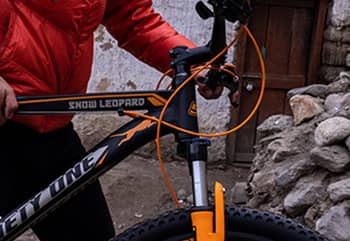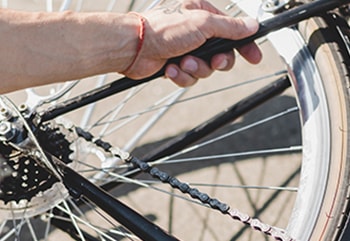All About Bicycle Gears

Do you wish you could ride a bicycle efficiently and effortlessly while going uphill, and, at speed on flat terrain without having to pedal vigorously and getting out of breath? If you've answered 'Yes' to this, then you would love and enjoy riding a geared bicycle, because gears are all about adding more output to your wheel from the effort you put in at the pedals.

For most people, the concept of shifting bike gears can be confusing and intimidating, and it can seem simpler not to touch them at all. But you won't go very far, literally and, enjoy your ride as much if you avoid using your bicycle gear. Bikes have gears so you can pedal comfortably no matter what the terrain, making your rides easier and more fun.
Read on to get an understanding of what bicycle gears are all about, how they work, and tips on using them.
What exactly are Bicycle Gears and How They Work
Bicycle gear is a system of multiple parts. You have shifters located one on each of the handles and are used to change and control or shift the gears.
The front gear is called the chainring or crankset and could be of either one, two, or even three counts around the chain wheel and is controlled by the left handle shifters. The biggest chainring is placed in the outermost position and is numbered in the descending order of their size. So, the smallest chainring is number one and so on.
The rear gear is called a cassette which is made up of different sized cogs or sprockets and controlled by the right shifters. Here, the biggest sprocket is the innermost and is considered sprocket number one. The proceeding ones continue as number two and so on. A chain connects the cassette with the chainrings. And finally, you have the derailleurs, one at the back wheel and in case of more than one chainring, you will have another derailleur in the front. This whole setup is connected by a cable from the shifters on your handlebar to the derailleurs.

When you use the shifters to move or shift your gear up or down, the derailleur derails the chain moving it from one sprocket to the next as they move from side to side. This is facilitated by the cable which connects the shifters to the derailleurs.
So that's about what makes up the gears and how it works. Now let's look at some essential tips on using gears that you must know so that you no longer feel daunted by them.
What you must know about Bicycle Gears
1) Chainrings and Pedaling
Pedaling feels easier while in a lower number chainring and harder in a bigger one.
2) Descending and Ascending
Use the higher gears for descending or to move at high speeds. Your chainrings or your left gear should be on the bigger or higher number. For ascending hills or inclines, or accelerating from a standstill you should use the low gear. So your chainring should be on the lowest ones.

3) Tandem Between Both Gears
Your right gears should be in tandem with your left gears. If your left gear is in the higher values, your right ones should be high as well. For example, if your left shifter is on the biggest chainring, number 3, the right gear should ideally be from 4-6. See this table. Green indicates the settings that are good to use and the values that are in gray boxes should ideally not be used. This example can be adapted for bicycles with more or even a lesser-r number of gears.

If you use the right-hand gears incorrectly and are not in sync with the left gears you will cross the chain. That brings us to the next point.
4) Don't Cross the Chain
Avoid using the opposite extreme ends of the gears. So for example don't use the smallest cogs on the back and the front, or the largest cogs on the back and the front. This pulls the chain between them at an angle, which can cause it to stretch and deform and over time it can wear out both, the chain and the gears.
5) Anticipate the Gear Change Depending on the Road Ahead
Watch the road anticipating the terrain change and so a required gear change. If you see an incline or climb coming up, do not wait to change to the low gear when you reach there. Make the change before that.
6) Don't Shift Gears too Quickly
If you are going down a hill or on the flat, don't be tempted to shift up to a higher gear as quickly as possible. Do it gradually or you run the risk of the chain jumping off the gears completely.

Also, keep on pedaling when you shift gears. And most importantly never shift the gears while you are at a standstill.
7) Big Changes and Fine Tuning
Remember, the left gear is for big changes and the right gear is more for fine-tuning. Say, when you need to shift down to a lower number gear due to an incline, use the left shifter to shift the front gears to a lower number which is an easier gear. Then fine-tune using the right shifter for the rear gears.
8) Less and More Pedaling Resistance
If you find that you're pedaling too fast and there isn't enough resistance, shift into a harder gear. You'll move faster. And if you find it is hard to turn the pedals, shift into an easier or lower gear.
If you think there are too many details to remember, it is all about experimenting, practicing and you will automatically develop muscle memory for using the gears appropriately. We hope you will use these tips and make use of the bicycle gears to make your ride more efficient, travel further, not as exhausting and all the while have fun.
If you're looking to buy geared cycle, check out the exciting range by one of the fastest-growing bicycle brand Ninety One.
Do you have tips on using bicycle gears that you would like to share with us? If yes, write to us at bikes@outdoors91.com
Related Blogs

Cycling Guides
Test Riding A BicycleFour critical parameters that you should consider while doing a bicycle test ride.

Cycling Guides
4-Step Bicycle Check Before Every RideFour bicycle checks that you must undertake each time before you ride.

Cycling & Health
Cycling In A Post-Pandemic WorldA surge in cycling is one positive impact that came as a result of the pandemic.

